Surgical attire
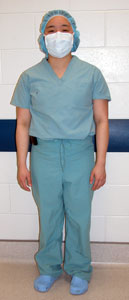
Scrub Suits
- worn to limit dirt, debris and bacteria carried into the operating area
- made of loose weave fabric
- V-necked shirt
- pants have drawstring or elastic waist
- shirts are tucked into pants
- cover with clean lab coat outside OR to minimize environmental contamination
- should not be worn to examine patients or change bandages if additional surgery is planned
- should be changed at least daily and whenever soiled
Head covers
- worn to reduce shedding of hair and bacteria into surgical field
- human hair harbors bacteria (eg. Streptococcus spp, Escherichia coli)
- decrease infection rates so should be worn by everyone in OR
- should cover all hair on the head
- hoods are used to cover facial hair (eg. beard, side burns)
Face mask
- made of glass fiber mesh sandwiched between 2 layers of cellulose fabric
- thin metal strip in the top of mask improves fit along the bridge of nose
- ties secured behind top of head and neck so is minimal venting
- ties should NOT be crossed at the back as this increases the size of side openings reducing filtering
- goals:
- protect surgical wound from saliva droplets and microorganisms from surgical team
- redirect airflow out sides of the mask away from incision
- less effective when excessive talking, sneezing and prolonged procedures
- should not be worn around base of neck between procedures (contaminates scrubs)
- new mask is worn for each procedure
- no strong evidence masks decrease infection rates, but currently is recommended
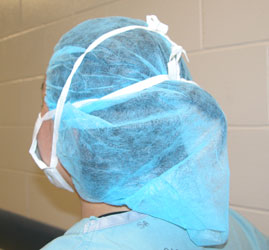
Shoe covers
- minimize outside dirt and debris in the surgical suites
- No evidence they decrease infection rates
- Mainly used in special situations or closed surgical suites
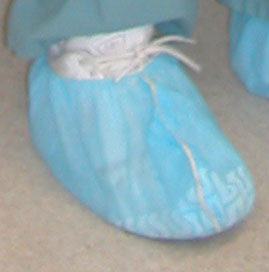
Surgical hand scrub
Goals of surgical scrub
- remove dirt and oils from hands and forearms
- kill microorganisms on surface
- not irritate or damage skin
- provide prolonged residual action
Hands have high bacterial counts especially if visibly dirty
- highest under and around nails
- Surgeons’ hands have higher numbers and more pathogenic organisms than average person This is because they are frequently exposed to scrub solutions (that kill off sensitive bacteria) and contaminated wounds
- jewellery is removed (can’t be effectively cleaned)
- nails are short and clean (easier to effectively clean)
- no false nails or nail polish (higher resident bacterial levels and can’t be effectively cleaned)
About Scrub procedure
- Ideal scrub time is NOT known
- 5 minutes is safe and effective
- Currently recommended: first scrub of day is 5 minutes, subsequent scrubs are 3-5 minutes (if minimal contamination of hands in between)
- Two commonly used scrub procedures:
- timed anatomic scrub
- all surfaces of each hand and forearm are scrubbed for a specified time
- time varies with desired total scrub time (3-5 minutes)
- counted brush strokes method
- all surfaces of each hand and forearms are given a specific number of brush strokes
- number varies from 10 - 25 depending on desired total scrub time
- Both result in similar total times
- timed anatomic scrub
- use moisturizing lotions between scrubs to reduce skin drying and bacterial shedding
- ensure lotion is formulated so it does NOT neutralize chlorhexidine’s residual action
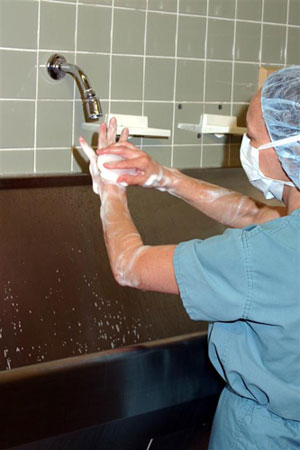
Before scrub procedure
Scrub Procedure (Movie)
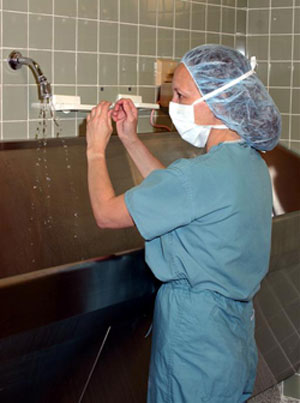
-
adjust cap to ensure all hair is covered
-
tie clean mask securely ensuring it comfortably covers nose and mouth (ties are not crossed)
-
tuck scrub tops into pants
-
remove jewellery
-
hold hands above elbows so water drains from fingertips towards the elbow
-
open disposable brush and place on shelf above scrub sink
-
perform preliminary wash: wet and wash hands and forearms to 5 cm above elbow using soap from dispenser
-
clean nails and subungual areas using nail cleaner in package
-
rinse hands and arms thoroughly
Scrub procedure
Detailed Example
- Remove brush from wrapper
- Apply water to scrub brush containing antiseptic scrub
- Apply lather to hands and arms to the elbows
- Minute 1: scrub one hand (nails, nail beds, each side of each finger and hand)
- Minute 2: scrub second hand in similar fashion
- Minute 3: scrub top half of each arm in a circular fashion beginning at wrist (1/2 minute each)
- Minute 4: scrub bottom half of each arm in circular fashion (1/2 minute each)
- Rinse hands and arms thoroughly
- Minute 5: apply fresh scrub from dispenser or brush, discard brush and scrub hands only
- Rinse hands and arms a final time and allow excess water allowed to drip off
Hands and forearms are now considered surgically clean ie. NOT sterile
Drying after scrub procedure
- Hands and arms are held up and away from body
- the towel should not contact the scrub suit or any non-sterile surface
- Use one half of the towel for each hand and arm
Gowning and Gloving
Gowns
-
A sterile gown are put on to place a sterile barrier between the surgeon and the patient
- should be
- water resistant
- resist friction, pressure and stretch especially at forearms, elbows and abdomen (ie. not be tight)
- produce minimal lint
- comfortable and economical
- bacteria can penetrate at cuffs and seams
- packaged individually
Gloves
goals:
- protect patient from contamination by microorganisms on surgeon’s skin.
- protect surgeon from patient’s microorganisms
- commonly made of latex
- not an absolute barrier as some gloves have holes
- accepted industry standard for new surgical gloves: < 1.5% have punctures before use
- by end of surgery, almost 1/3 have holes
- most on non-dominant thumb and index finger
- perforations NOT associated with more post-op infections likely because surgical hand scrubs reduce bacterial counts and suppress bacterial multiplication
BUT gloves should be changed when punctures are noted
- Powders are placed inside gloves to make easier to put on
- talc (magnesium silicate)
- induces acute inflammation followed by a chronic persistent granulomatous reaction when put into surgical wound (eg. glove punctures)
- cornstarch
- causes more intense acute inflammatory reaction (especially in joints) but resolves after 4 weeks
- talc (magnesium silicate)
Changing gloves
Removing gloves
- requires a non sterile assistant to remove gloves
- cuffs are pulled over hands if closed gloving technique is to be used
- hands are pushed through cuff if open gloving technique is to be used
Changing gloves with closed gloving technique
- Involves gloving with hands covered by cuffs of gown
- Used when do not have a sterile assistant
- Procedure is the same as used when initially gloving
Open gloving
- involves gloving with the hands pushed through the cuffs of gown
- generally reserved for changing glove during surgery
- procedure requires sterile assistant to assist gloving

